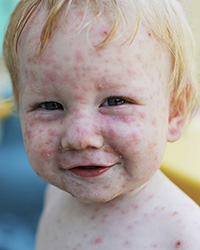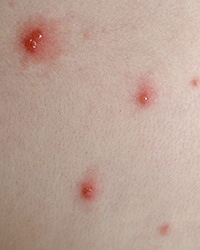What is chickenpox (varicella)?
Chickenpox is a common and preventable infection caused by the varicella-zoster virus.
What are the symptoms of chickenpox?
- Fever;
- Tiredness;
- Loss of appetite;
- Headache;
- Itchy rash all over the body that turn into small blisters. The blisters then dry up and scab over. The rash comes in clusters and can be very uncomfortable.
Chickenpox can be dangerous to pregnant women, infants, and patients with cancer and other immunocompromising conditions (weakened ability to fight off infections).

It can take between 10 to 21 days after contact with the germ before symptoms appear.
How does chickenpox spread?
Chickenpox can spread easily from person to person through:
- Breathing in contaminated air from a person infected with the germ who is sneezing, coughing, or speaking.
- Touching or breathing in the germ from the fluid in the blisters before it scabs over.
- A pregnant woman passing it to their baby before they are born.
Shingles is an infection caused by the same virus that causes chickenpox. If a person never had chickenpox or the chickenpox vaccine and is exposed to shingles, then that person can get chickenpox. A person can only get shingles if they have had chickenpox in the past. For more information on shingles, visit www.wechu.org.

How long is it contagious?
Chickenpox is very contagious. A person can spread the germ 1 to 2 days before the rash appears and until all the blisters crust over. This is often about 5 days after the start of the rash. A person who does not have a strong immune system may be contagious for longer.
How is chickenpox treated?
If you or your child has these symptoms, see your health care provider. For mild symptoms, treatment includes supportive care for the symptoms. In more severe cases, treatment may also include antiviral drugs (medications that fight viruses).
- Drink plenty of fluids to stay hydrated.
- Keep fingernails short and encourage your child not to scratch. Scratching may cause infection from bacteria that gets through the skin. To help with scratching, try bathing often and applying a calamine lotion or a cream suggested by your health care provider.
- Consider using medications for fever, such as acetaminophen. Discuss with your health care provider how much to give your child or follow dosage recommendations on the label. Do not use medications that have salicylates, such as aspirin, because it can increase your child’s risk for Reye syndrome.
How is it prevented?
The best way to prevent chickenpox is to make sure you and your child are up-to-date with all of your vaccinations. The two-dose chickenpox vaccine series are free, as part of Ontario’s publicly funded vaccine program. Vaccines help protect you from serious illnesses.
Follow these other tips to avoid getting sick.
For more information contact the Health Unit or speak to your health care provider.
References:
American Academy of Pediatrics. (2018). Red book: 2018-2021 Report of the committee on infectious diseases (31st ed.). D.W. Kimberlin, M.T. Brady, M.A. Jackson, & S.S. Long (Eds.). Itasca, IL.
American Public Health Association. Control of communicable diseases manual (20th ed.). D.L. Heymann (Ed.). Washington, DC.
Ontario Ministry of Health and Long-Term Care. (2014). Infectious diseases protocol, Appendix A: Disease-specific chapters, Chapter: Varicella (chickenpox). Toronto, ON: Queen’s Printer for Ontario.

